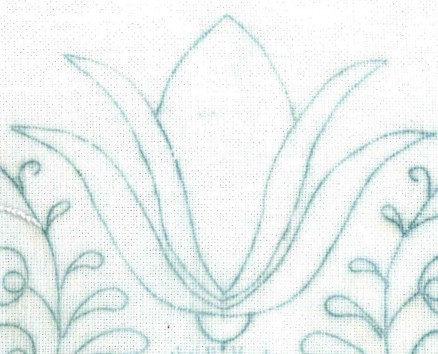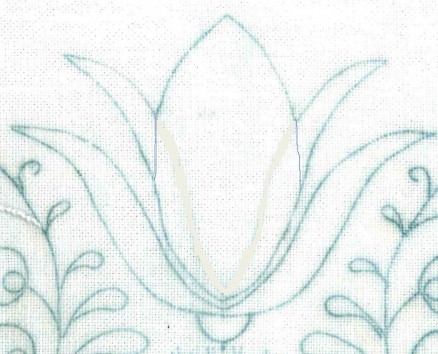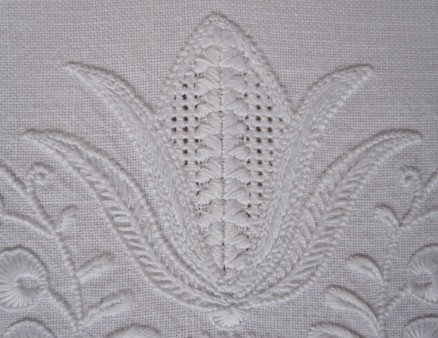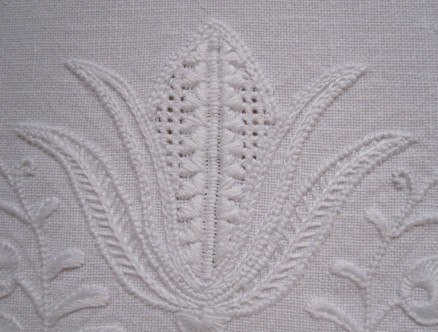The center circle is flanked by additional tulips. The outline is shown here a little bit enlarged:
 The center part of the tulip is well suited for a filling pattern. Outside the center are 2 narrow, long and pointed petals on each side. How to stitch those forms?
The center part of the tulip is well suited for a filling pattern. Outside the center are 2 narrow, long and pointed petals on each side. How to stitch those forms?
To better accommodate the center section’s filling pattern, it would be possible to change the lines of the upper petals.
 Regardless, the shapes of the outside petals are too narrow to embellish them with withdrawn thread patterns. There must be other ways.
Regardless, the shapes of the outside petals are too narrow to embellish them with withdrawn thread patterns. There must be other ways.
On the oval runner the petals were embroidered with Satin stitches. To control the stitches and to keep them neat, the petals had to be divided. (More detailed information on how to stitch divided leaves can be found in Basic Principles of Schwalm Whitework, pages 29 and 30).
 In the center part of the tulip the Limet Pattern “Kleiner Reißverschluss – versetzt gearbeitet” (Wickelstiche I, page 29) was worked.
In the center part of the tulip the Limet Pattern “Kleiner Reißverschluss – versetzt gearbeitet” (Wickelstiche I, page 29) was worked.
Coton à broder in the following sizes was used: No. 20 for the Coral Knot stitches, No. 25 for the Satin stitches and the filling pattern, No. 30 for the Chain stitches.
It is also possible to stitch the outlines of the pointed petals with Coral Knot stitches and to fill the remaining area with Satin stitches (as worked on the rectangular runner, seen in the picture below).
As mentioned in an earlier post, in early Schwalm whitework there are many patterns suitable for long, narrow shapes. So, I used the opportunity to mix both techniques here also. In the bottom petals I used an element of the early Schwalm whitework embroidering a variation of the Wheatear stitch (Early Schwalm Whitework, page 75).
 In the middle section of the tulip, one stripe of the Limet pattern “Krönchen” (Limetrosen I, page 55) was worked. The areas at both sides were filled with Four-Sided stitches. For the tulip opposite, I made some changes; the areas of the top petals, inside the Chain stitches, remain free of further embellishment, and I worked one row of Satin stitches between the “Krönchen” stitches to get the pattern centered.
In the middle section of the tulip, one stripe of the Limet pattern “Krönchen” (Limetrosen I, page 55) was worked. The areas at both sides were filled with Four-Sided stitches. For the tulip opposite, I made some changes; the areas of the top petals, inside the Chain stitches, remain free of further embellishment, and I worked one row of Satin stitches between the “Krönchen” stitches to get the pattern centered.
 Coton à broder in the following sizes was used: No.16 for the Coral Knot stitches, No. 20 for the Satin stitches and the variation of the Wheatear stitch, No. 25 for the Chain stitches and the filling pattern.
Coton à broder in the following sizes was used: No.16 for the Coral Knot stitches, No. 20 for the Satin stitches and the variation of the Wheatear stitch, No. 25 for the Chain stitches and the filling pattern.
The first part of this series can be found here.
The previous part of this series can be found here.



Leave a Reply